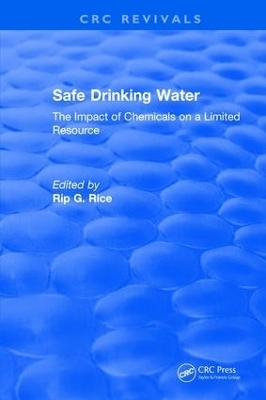
Safe Drinking Water
CRC Press (Verlag)
978-1-138-50505-6 (ISBN)
In an effort to address one of the major issues confronting the future of the nation’s drinking water supplies, chemical contamination, the Drinking Water Research Foundation and the American Chemical Society presented the symposium, "Safe Drinking Water: the Impact of Chemicals on a Limited Resource." To add balance to the total presentation, two papers were included that were not part of the symposium.
Many questions as to the public significance of hundreds of organic chemicals known to be present in the national drinking water supply are waiting to be answered. In some areas of the country, aid rain-induced alterations of the natural leaching process represent an unexplored potential source of toxic pollutants. Finding workable ways to clean up the water supply will be an ongoing task.
Addressing these questions, as well as investigating how other countries are responding to these problems, the alternate sources available, such as bottled water, and point of use devices, the presenters in this symposium have attempted to explain the problems, situation, and alternatives.
As progress is made in one area, setbacks will occur in another. As we eliminate problems thought chemical technology, we often create others, such as contamination of our waters.
While all the situations, problems, and alternatives are not discussed in these proceedings, it is hoped that some attention will be brought to the public, government, and private sectors so that future work will be done to assure the nation of safe drinking water resources.
Dr. Rip G. Rice received his PhD degree in Organic Chemistry from the University of Maryland, and has more than 36 years of varied experience in the deferal government, aerospace, the chemical industry, and as a private consultant in government liaison, envitonmental engineering, and water and wastewater treatment. In 1973, Dr. Rice co-founded the Internation Ozone Association, is a member of its Board of Directors, and has served as its President during 1982 and 1983. During the period 1977-1980, he was a member of a consulting team of speacialists funded by the U.S. Environmental Protection Agency to survey and analyze European and Canadian water treatment practices involving the used of ozone, chlorine dioxide, granular activated carbon, and biological treatment processes. Recently, Dr. Rice conducted an extensive literature review of the oxidation products formed when drinking water is treated with various oxidizing agents, for EPA's Office of Drinking Water. Dr. Rice is coeditor of the series of books entitled, "Handbook of Ozone Technology and Applications," and coauthor of the book "Biological Activated Carbon," both published by Ann Arbor Science Publishers, Inc. In addition, Dr. Rice has edited 10 monographsand proceedings for the International Ozone Association. A member of the AWWA, WPCF, Sigma Xi, IOA, AiChE, the International Bottled Water Association, and the Technology Transfer Society, Dr. Rice recently has been appointed to teh Joint U.S./USSR Work Group on the Prevention of Water Pollution from Industrial and Municipal Sources, directed by the U.S. Environmental Protection Agency.
PART I - NATIONAL AND INTERNATIONAL PERSPECTIVES 1. Chemicals and Safe Driving Water: National and International Perspectives Robert A. Neal, Ph.D. 2. Drinking Water: A Global Victual J. R. Hickman, B. Pharm, M. S. PART II - SOURCES & DISTRIBUTION OF SAFE DRINKING WATER 3. Public Drinking Water and Chemicals James F. Manwaring, P. E. 4. Bottled Water: An Alternative Source of Safe Drinking Water Jerry T. Hutton, Ph.D. 5. Overview of Point-Of-Use Water Treatment Technology P. Regunathan, Ph.D. PART III - CHEMICALS IN DRINKING WATER 6. An Effective Alternative of Official Regulation of Indirect Additives to Drinking Water Nina I. McClelland, Ph.D. 7. The Water Treatment Chemicals Codex Robert A. Rehwoldt, Ph.D. 8. Disinfectant Chemistry in Drinking Water - Overview of Impacts on Drinking Water Quality A. A. Stevens, L. Moore, R. C. Dressman, and D. R. Seeger 9. By-Products of Chlorination: Specific Compounds and Their Relationship to Total Organic Halogen Daniel L. Norwood, G. P. Thompson, J. J. St. Aubin, D. S. Millington, R. F. Christman, and J. D. Johnson 10. Ozone for Drinking Water Treatment – Evolution and Present Status Rip G. Rice, Ph.D. 11. The Occurrence of Contamination in Drinking Water From Groundwater Sources Hugh F. Hanson, P.E. PART IV – MONITORING 12. Improved Monitoring Techniques to Assess Groundwater Quality Near Sources of Contamination Glenn E. Schweitzer 13. NBS Environmental Standard Reference Materials for Use In Validating Water Analysis R. Alvarez PART V – REGULATORY ASPECTS 14. Regulation of Contaminants in Drinking Water Joseph A. Cotruvo, Ph.D. 15. Federal Protection of Groundwater Timothy L. Harker, Esquire 16. The World Health Organization and Guidelines and European Economic Community Directives J. R. Hickman, B. Pharm, M.S. 17. Regulatory Flexibility and Consumer Options Under the Safe Drinking Water Act Timothy L. Harker, Esquire 18. Structure and Regulation of the European Bottled Water Industry Rip G. Rice, Ph.D., and G. Wade Miller 19. Congressional Initiatives Honourable Robert T. Stafford 20. Conference Summation Timothy L Harker, Esquire
| Erscheinungsdatum | 05.10.2017 |
|---|---|
| Reihe/Serie | CRC Press Revivals |
| Verlagsort | London |
| Sprache | englisch |
| Maße | 152 x 229 mm |
| Gewicht | 453 g |
| Themenwelt | Naturwissenschaften ► Chemie ► Technische Chemie |
| Naturwissenschaften ► Geowissenschaften ► Hydrologie / Ozeanografie | |
| Technik ► Bauwesen | |
| Technik ► Umwelttechnik / Biotechnologie | |
| ISBN-10 | 1-138-50505-6 / 1138505056 |
| ISBN-13 | 978-1-138-50505-6 / 9781138505056 |
| Zustand | Neuware |
| Haben Sie eine Frage zum Produkt? |
aus dem Bereich


